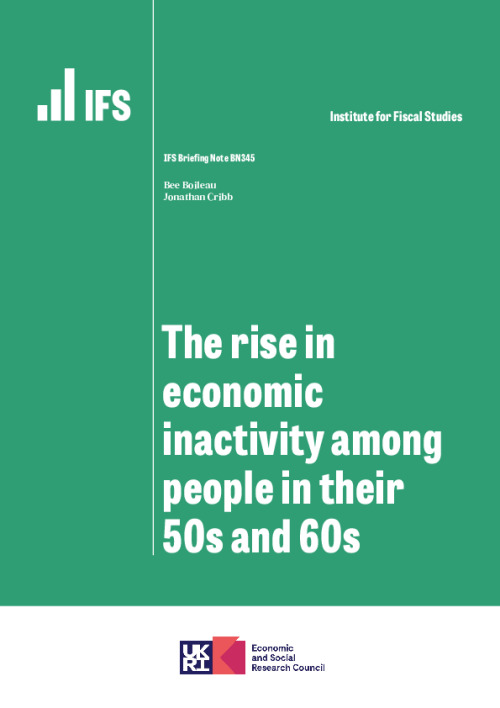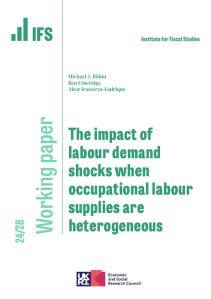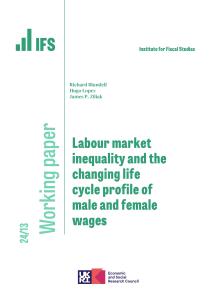Since the COVID-19 pandemic started, the UK has seen a rise in the rate of economic inactivity among older people. This is a reversal of earlier trends. In particular, the proportion of people aged over 50 who are economically inactive – neither in work nor actively searching for work – had fallen steadily in the decade prior to the pandemic. This change of employment patterns for older people comes despite very little change in ‘unemployment’ (people out of work and searching for a job) – which early in the pandemic was widely expected to reach very high levels. In July 2020, the Office for Budget Responsibility (2020) forecast unemployment of 10% in 2021. In fact, the unemployment rate (for people aged 16+) peaked at just over 5% in late 2020 and by the first quarter of 2022 had fallen back to its pre-pandemic level of just 3.7%.
In the face of these modest changes in unemployment, it is more surprising that there has been such a large fall in employment – and rise in economic inactivity – that has been concentrated amongst older people. The number of people in paid work in the first quarter of 2022 was 32.6 million, 500,000 lower than its pre-pandemic peak of 33.1 million in the three months to February 2020. As we show, this fall has been concentrated among 50- to 69-year-olds.
There are a range of potential reasons for the rise in economic inactivity. First, increases in economic inactivity could be driven by lower levels of labour demand – shown, for example, by higher levels of redundancies – and that older people respond by no longer looking for work rather than being officially ‘unemployed’. Second, rising economic inactivity could be driven by an increased number of people unable to work for health reasons, perhaps as a result of COVID or long COVID. Alternatively, people may want to avoid the potential exposure to COVID that comes through greater contact with other people in the workplace. Third, a trend towards remote work might have prompted some workers to take early retirement, if opportunities for socialisation are a factor keeping people in work at older ages, or if people who worked from home appreciated the extra time at home and did not want to return to the workplace. Fourth, people could have chosen to take early retirement, for a variety of reasons, including having increased their wealth during the pandemic, when consumption opportunities were minimal, and when asset prices (particularly housing) increased.
This report seeks to shed new light on the fall in employment and rise in economic inactivity amongst older people in the UK, with a particular focus on those in their 50s and 60s.
Key findings
- The rate of economic inactivity among people in their 50s and 60s has risen since the start of the pandemic. It rose from 35.4% in the first quarter of 2020 to 36.5% in the first quarter of 2022, an increase of 1.1 percentage points, back to the level seen at the end of 2018. This follows many years of falling inactivity prior to the pandemic; the inactivity rate for this group had been 42% in 2010. Falls in inactivity were always likely to slow because 2021 was the first year in a decade in which the state pension age was not rising, but the rises in inactivity had not been anticipated.
- The rise in economic inactivity has been larger for people in their 50s and 60s than for people younger or older than them. While those aged 70+ have also seen an increase in economic inactivity, it has been much smaller than for 50- to 69-year-olds, and 35- to 49-year-olds saw no change at all. With an increase of 270,000 economically inactive 50- to 69-year-olds when comparing October 2021 to March 2022 with the same period two years earlier, 43% of the overall rise in economic inactivity in the UK population since the pandemic began has been driven by changes among 50- to 69-year-olds.
- The fraction of 50- to 69-year-old workers moving from employment directly into retirement or other forms of economic inactivity increased substantially during the pandemic. This was the key driver of the rise in economic inactivity. It contributed two-thirds of the increase in inactivity over the last two years compared with pre-pandemic data. The remaining third of the increase in inactivity was due to fewer people leaving inactivity for employment, and more people moving from unemployment to economic inactivity, than pre-pandemic.
- More than half of the growth in 50- to 69-year-olds leaving work for economic inactivity seen during the pandemic was due to people reportedly leaving work because they were retiring. Retired people are less likely to return to work than people (of the same ages) in other forms of inactivity. Indeed, they are unlikely to ever return to employment – previous research has found that only 5–10% of retired people ever return to paid work.
- On some dimensions, the rise in economic inactivity has been very broad based. Strikingly, there has been relatively little difference in the trends of 50- to 69-year-olds leaving employment for inactivity between men and women, between those with and without degrees, between those in professional and non-professional occupations, and between public and private sector employees.
- However, there have been particularly large increases in the proportions of part-time workers, self-employed workers and workers in their 60s moving out of employment and into economic inactivity during the pandemic. These are all groups that are in some sense closer to retirement than full-time workers, employees, and those in their 50s. There have also been slightly larger increases in the rate of leaving paid work for economic inactivity amongst those working in occupations where it is relatively easy to work remotely than amongst those working in occupations where it is harder, or not possible, to work from home.
- Importantly, we do not find differences in the increase in rates of leaving employment for inactivity between those working in occupations that have seen particularly high, or relatively low, growth in vacancies over the last two years. This suggests that weak labour demand for particular occupations or skills is unlikely to be driving the increased rates of inactivity in this age group. It also suggests that higher inactivity for 50- to 69-year-olds is likely to be contributing at least partially to the labour market tightness seen in some areas.
- Redundancies and dismissals significantly contributed to increases in 50- to 69-year-olds moving from employment into inactivity in 2020, but much less so in 2021. Over a third (37%) of the increase in 50- to 69-year-olds leaving the labour force between pre-pandemic data (2017–19) and 2020 was driven by redundancies or dismissals. But as the economy recovered in 2021, these only made up 11% of the growth between 2017–19 and 2021. It appears that redundancies do not continue to play an important role in driving higher inactivity rates.
- Overall, it does not seem as if poor health is the primary driver of these increases in economic inactivity rates. The fraction of workers in their 50s and 60s moving from employment into being economically inactive due to ‘long-term sickness or disability’ has stayed relatively constant, with around 0.3–0.5% of 50- to 69-year-old workers per quarter making this transition both before and after the pandemic. Growth in health-related reasons for leaving the labour force only accounts for 5% of the overall growth in inactivity among this age group. And changes in transitions from employment to inactivity are similar between those with and without a long-standing health condition.
- Overall, the rise in economic inactivity among 50- to 69-year-olds does not look to be driven primarily either by poor health or by low labour demand leading to people being unable to find work and becoming discouraged. It looks more consistent with a lifestyle choice to retire in light of changed preferences or priorities, possibly in combination with changes in the nature of work post-pandemic (in particular more remote work) which reduce the appeal of staying in employment.












